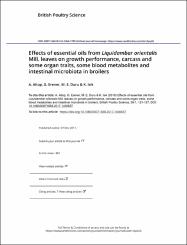Effects of essential oils from Liquidambar orientalis Mill. leaves on growth performance, carcass and some organ traits, some blood metabolites and intestinal microbiota in broilers
Özet
1. This study was carried out to investigate the effects of liquidambaressential oils (LEO) isolated from Turkish sweet gum (Liquidambar orientalis Mill.) leaves on growth performance, carcass, edible inner organs (EIO), gastrointestinal traits (gut), some blood metabolites and jejunum microbiota in broilers.2. A total of 375 one-d-old male broilers (Ross 308) were randomly allocated to 5 treatments with 5 pens with 15 birds. The birds were fed on diets without antibiotics (CONT), with antibiotic (50mg per kg, AB), with LEOs at 0.0405 (0.04LEO), 0.0811 (0.08LEO) or 0.1622 (0.16LEO) g/kg feed up to 42 d of age. The levels of LEOs included to diets were determined according to in vitro antimicrobial activity.3. From d 1 to 42, the 0.08LEO treatment had higher live weight gain (LWG) compared to others. The 0.08LEO treatment increased feed intake (FI) compared to the CONT, AB and 0.04LEO. However, the feed conversion ratio (FCR) of these birds was lower than those in the AB and 0.16LEO treatments. From 1 to 42 d of age for LWG, the effects were quadratic and cubic, while those for FI and FCR were cubic and quadratic, respectively. Birds that fed 0.08LEO and AB diets had higher and lower carcass weights (CW) than those that fed other diets. The effect of LEO levels was cubic on the CW. The 0.08LEO and 0.16LEO decreased abdominal fat (AF) weight compared to the AB. The blood cholesterol decreased by the 0.04LEO and 0.08LEO treatments compared to the CONT. For the blood cholesterol, the effects of LEO levels were cubic. The 0.08LEO treatments decreased Escherichia coli counts in jejunum compared to the CONT and 0.16LEO.4. Feeding a diet with LEO at 0.0811g/kg might increase the LWG, FI and weights of carcass and AF, whereas it might decrease blood cholesterol and E. coli counts without affecting blood high-density lipoprotein, low-density lipoprotein, triglyceride, glucose, aspartate transaminase and alanine transaminase concentrations.


















